Kidney Disease in Cats – Renal Insufficiency and Chronic renal failure
MANAGING EARLY KIDNEY DISEASE IN CATS – RENAL INSUFFICIENCY AND CHRONIC RENAL FAILURE
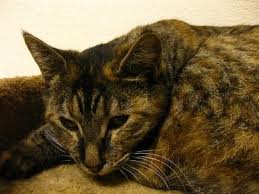
[ad name=”Tweet”]
Early kidney disease is one of the most common diseases in cats over the age of twelve years. Nowadays cats are living longer and longer with the better care we give them and the higher quality of pet food available on the market. This means that in first world countries, almost half the cats a vet will see will be ‘senior’ pets.
Kidney disease is unfortunately irreversible and occurs because of a number of different factors:
- Every day wear and tear. The kidney is made of hundreds of tiny tubules called nephrons that filter the blood to produce urine. As with any older machine, the filters can become damaged or leaky over time and lose their general effectiveness.
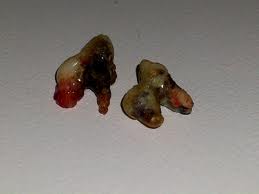
- Bad teeth. Bacteria on the teeth and gums can be absorbed into the bloodstream and become trapped inside the tiny arteries and veins in the kidneys forming micro abscesses which effectively damage the blood supply to the single nephron the artery is supplying, making it die off. With bacteria from rotten teeth being absorbed into the bloodstream on an almost daily basis, one can see that over time, more and more single nephrons will become damaged and die off.
- Kidney infections. If your cat has ever has a kidney infection this could cause damage to the kidney.
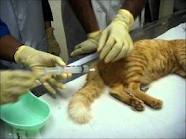
- Blocked bladder. If you have a male cat with a history of having had a blocked bladder, be aware that the blocked bladder could have caused kidney damage due to back pressure of urine onto the kidneys. Once the bladder is completely full the urine builds up and stretches the kidney to capacity leading to scarring and damage depending on how bad the blockage is and for how long it was there before it was treated.
- High blood pressure. Cats with high blood pressure can have kidney damage as the high blood pressure pounds the thin filter between the arteries and the nephron, damaging it over time. Kidney disease itself can lead to high blood pressure which is a vicious cycle. But high blood pressure can also occur in other diseases, such as hyperthyroidism in cats.

Early kidney disease is also known as Renal insufficiency, which means that the kidneys are not working to their full potential. This can progress to kidney failure. The kidneys have a large functional reserve. Most cats will only show signs of full kidney failure when more than 75% of the kidneys are no longer working.
The aim of treating renal insufficiency is to try and control and slow down the rate of progression of kidney disease before the cat goes into stage 4 kidney failure and has to unfortunately be put to sleep as the kidney disease is too advanced. We want to catch the kidney disease early as at that stage:
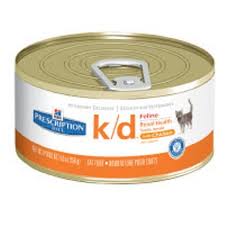
- The cat is usually eating well so putting it onto the correct diet is a lot easier
- The cat hasn’t lost a lot of weight
- High blood pressure can be picked up and treated and properly diagnosed – i.e. the cause of the high blood pressure can be identified, to stop ressure on the kidneys. High blood pressure can also damage the eyes so it is important to treat it.
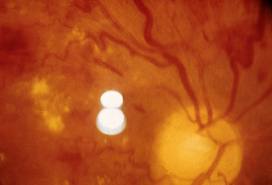
- Cats will take medication in the food more easily if they are actually eating and it will stay down if they are not vomiting from kidney failure.
- Catching it early often means that your cat may not have to stay in hospital for three days on a drip to get rehydrated which saves you vet bills and your cat stress.
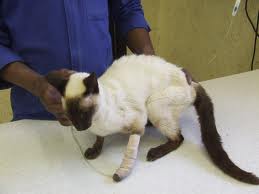
HOW YOUR VET WORKS OUT WHAT STAGE OF KIDNEY DISEASE YOUR CAT IS IN
Your vet will need to examine your cat, take a urine sample and do a blood test. Your vet will then look at all the results together and decide.
On examination, your vet will
- Feel the kidney’s size and shape. He or she will check if they are small which could indicate old age kidneys, enlarged which could indicate things like tumours, polycystic kidney disease, hydronephrosis (kidneys are replaced with fluid and very little kidney tissue remains) and viral diseases such as feline infectious peritonitis.

Lymphoma cancer in the kidneys makes them feel lumpy and bigger than normal - Check the hydration status of the cat. Most cats with kidney disease, especially advanced kidney disease will have some element of dehydration.
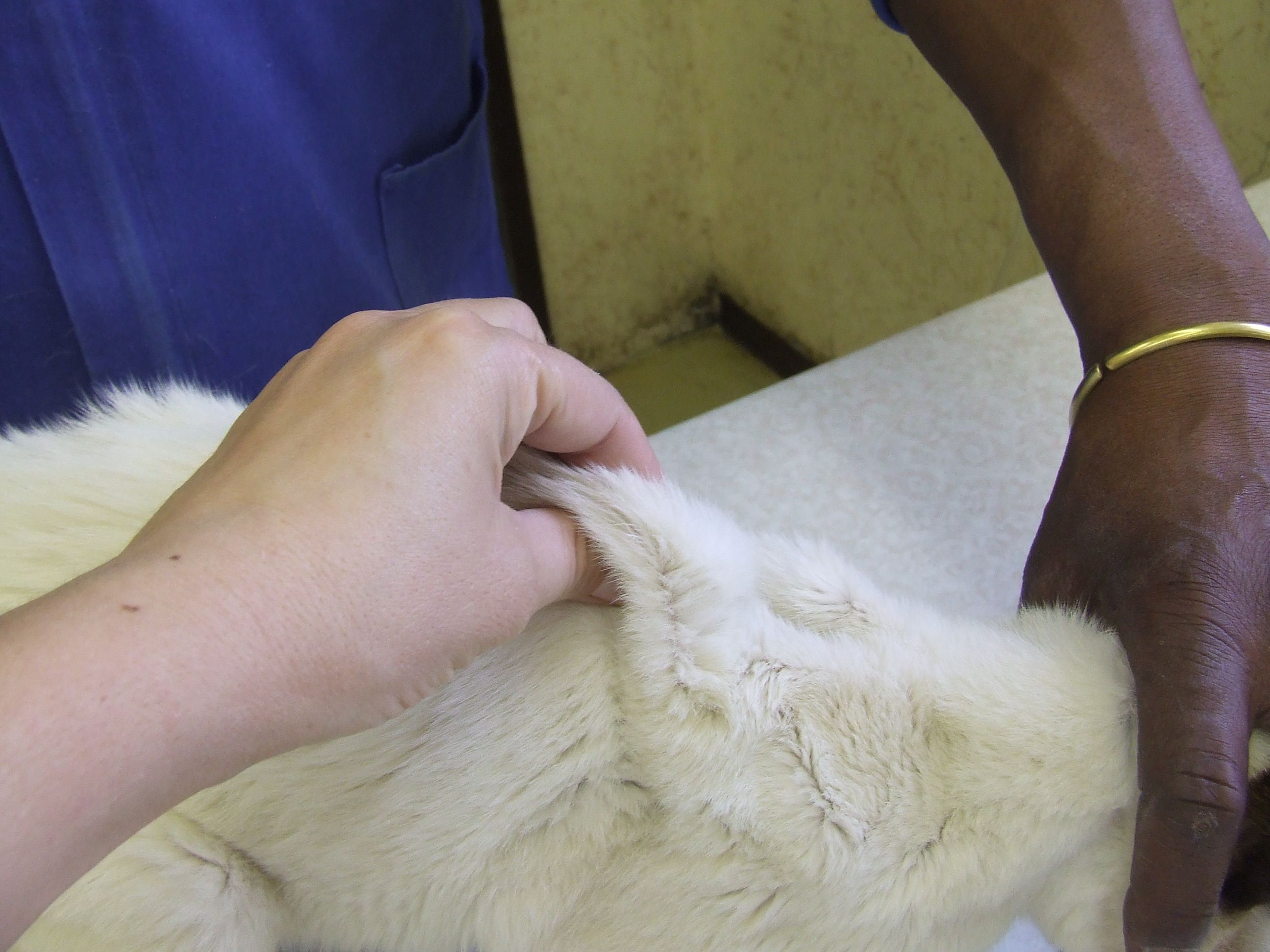
Checking for dehydration by lifting the skin and seeing if it “tents” - Check the mouth – cats with advanced kidney disease often have very smelly breath, ulcers on the tongue and gums and very inflamed gums. This is because the poisons in the body that the kidney should be getting rid of are building up and they get excreted in the saliva.
- Feel the bladder. Often cats with kidney failure or early renal disease will have large bladders filled with dilute urine.
- Check the eyes of your cat. Your vet will see if there is any bleeding at the back of the eye which could indicate high blood pressure. Also if there a protein called fibrin inside the eye it can indicate viral diseases such as FIP which affect both the kidney and the eyes of cats
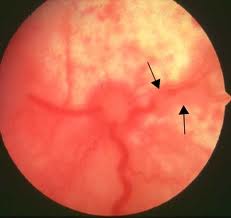
- Check the blood pressure of the cat. If your vet suspects kidney or thyroid disease, it is important that the blood pressure is taken. A few readings need to be taken – about five over the course of the day.
A urine sample will be taken:
The main thing your vet will look for if he/she suspects kidney disease is how concentrated the urine is. If your cat is dehydrated, the urine should never be a light yellow colour. The normal response of the body when it is dehydrated is to reabsorb water from the urine to keep it in the body. Kidneys with kidney disease lose the ability to either concentrate the urine or to make it over dilute. In kidney disease, the urine is the same concentration as the blood which is between 1,008 and 1,020.

Your vet will also check for the presence of protein in the urine. Some kidney diseases that can lead to kidney failure (such as glomerulonephritis) can cause massive amounts of protein to be lost in the urine. Your vet will also correlate the amount of protein lost to whether there is a urinary tract infection present as a normal urinary tract infection with bacteria, red blood cells and white blood cells will also have masses of protein lost. This would be easily treatable with antibiotics which would clear up the infection and thus the proteinuria.
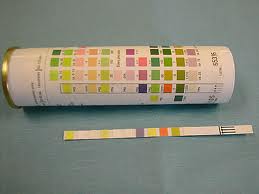
The presence of infection. Some infections are in the bladder only and shouldn’t affect kidney function. Other infections in the kidney can cause kidney damage. Your vet will look at the pH of the urine, whether there are red and white blood cells and whether the bacteria are producing nitrite which is occasionally seen in infection.
The presence of bilinogen – a bile pigment in the urine. This indicates that there are potentially liver problems causing dilute urine as opposed to kidney problems causing dilute urine.
BLOOD TESTING
The mainstay of diagnosis of kidney disease is blood testing. Your vet should look for a number of different things in the blood that would lead them to diagnose kidney disease.
- Creatinine – this is a breakdown product of muscle metabolism that is filtered out of the blood by the kidneys. It cannot leave the bloodstream in any other way than via the urine. Thus if the kidneys do not work it will build up in the blood and give an indication of how well they are working.
- Urea – this is the main chemical constituent of urine and is noxious waste that needs to be filtered and excreted by the kidneys. If the levels of urea are raised, then your vet will be suspicious of kidney disease. But other factors can influence urea levels too.
- Potassium – this can be low or high in kidney disease. If it is high it needs to be treated promptly as high potassium can affect the heart. If it is low, it needs to be supplemented.
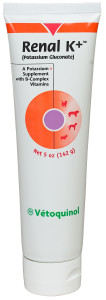
- Phosphate and calcium – these minerals work in harmony with each other and if out of balance can damage the kidney further
- Albumin and total protein – Kidneys that are losing protein will primarily lose albumin the main blood protein, leading to a low albumin.
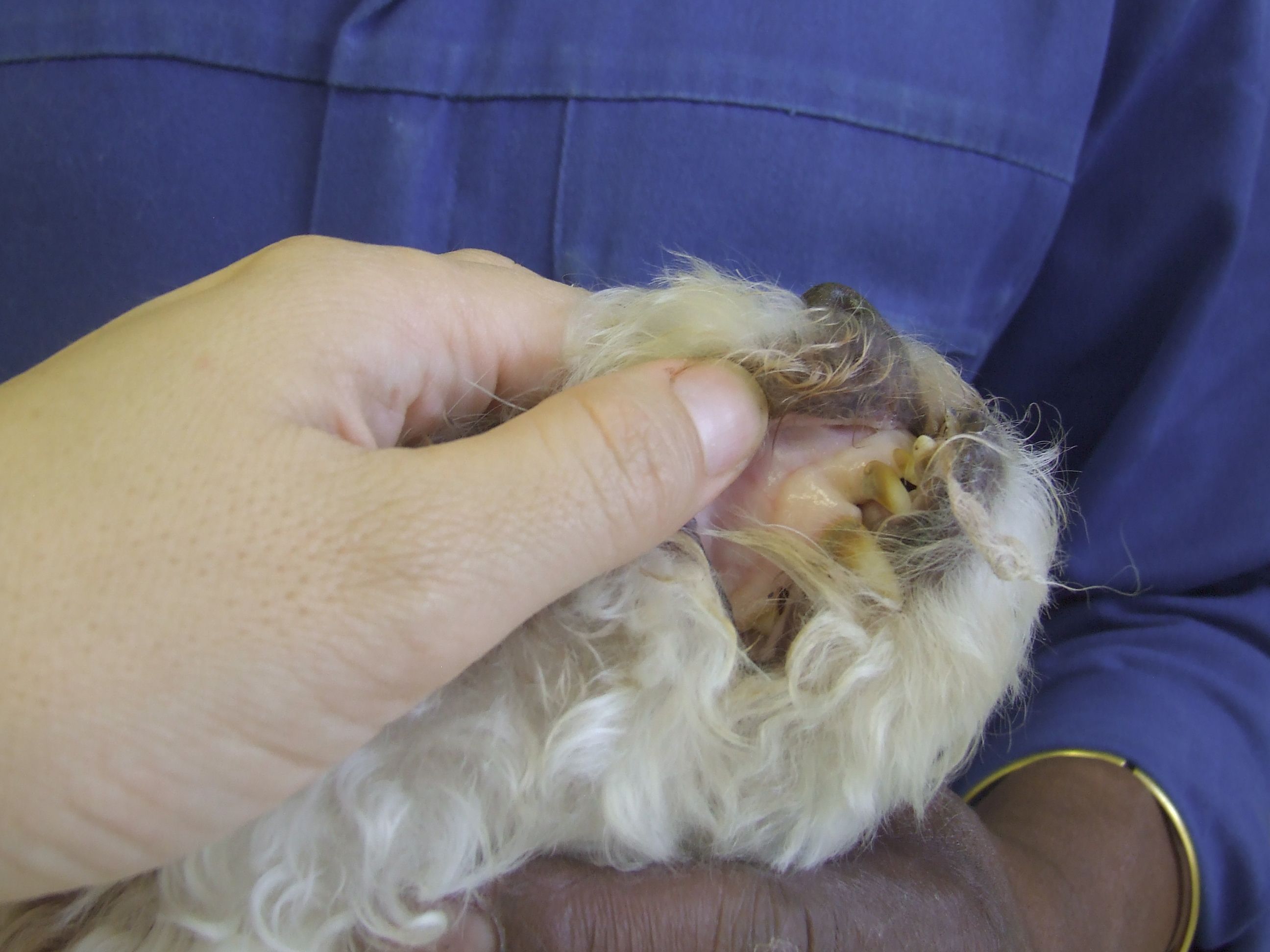
Pale gums can indicate anemia from kidney disease in both dogs and cats - Red blood cell count. The kidneys produce a hormone called Erythropoetin which normally makes the bone marrow produce red blood cells. If there is very little working kidney left, Erythropoietin levels may drop causing an anaemia which can be fatal.
- White cell counts. Elevated white cell counts can point to infection or cancer or immune disease of the kidneys.
ULTRASOUND
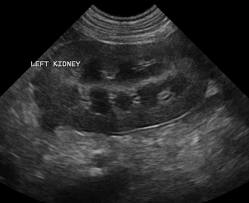
This is advised to rule out tumours, kidney stones and other rare kidney conditions that will affect the long term prognosis of treating the kidney disease.
TAKING ALL OF THIS INTO ACCOUNT – TREATMENT OF RENAL INSUFFICIENCY AND CHRONIC RENAL FAILURE
Kidney disease is suspected if the urine is dilute in a dehydrated animal with elevated kidney enzymes. It is then staged using the blood test run on creatinine. I prefer to stage kidney disease once the animal has been rehydrated, as a dehydrated animal will have elevated levels of everything in the blood. I use an initial test for diagnosis and then once the animal is rehydrated, I stage the kidney disease.
Stage 1: Creatinine is less than 140 umol/l RENAL INSUFFICIENCY
The levels of creatinine and urea are normal but animals are showing early signs of kidney disease, or renal insufficiency. They tend to pass larger volumes of urine, which is not concentrated and thus tend to get dehydrated easily. They thus tend to be thirstier than they used to be. Owners will say that they look well, eat well but seem to be more drinking more than they used to.
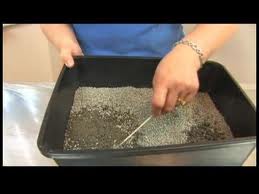
The kidneys can feel smaller than they should. The blood pressure may be elevated. This is the ideal stage to start treatment by doing basic things like getting the cat onto a kidney diet which is far easier on the kidneys than things like tuna, and store bought cat food which is high in phosphate, salt and the wrong sorts of protein. These produce a lot of ammonia when they are digested and that hits the kidneys hard. Cats can also be put onto wet food which allows them to get more water in when they eat.
Stage 2: Creatinine 140-249 umol/l EARLY RENAL FAILURE
Cats at this stage are given drugs such as benazepril to increase the blood flow through the kidneys so that the remaining kidney tissue can filter more blood per heart pump. They also help to decrease high blood pressure in the body which prevents more damage to the kidneys.
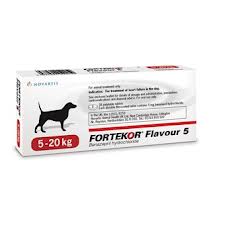
They stimulate appetite and cats tend to gain a little weight back. Cats are also often initially flushed out with a drip which immediately hydrates them, and makes them feel a lot better. They are put onto a kidney diet – many are commercially available through manufacturer such as Hills Science, Royal Canin and Eukanuba. Owner should be aware that cat’s tastes vary and if the cat refuses 1 brad, the other brands should be tried before deciding that the cat will not eat the food.
SHOULD I TREAT MY CAT IN STAGE ONE OR TWO KIDNEY DISEASE?
The answer is yes. This is the best stage to treat them, before they get bad. Treating them at this stage will greatly improve the length and quality of life by taking strain off the aging kidneys when they need it most. Even if you do nothing more than put them on the correct diet, it can only help.
Stage 3: Creatinine 250-439 umol/l RENAL FAILURE
Cats at this stage are hospitalized and put onto a drip for two to three days. This rehydrates them which helps them feel better and also flushes many of the toxins out through the kidneys. They are then put onto the correct food, and Benazepril to send more blood through the kidneys. Any minerals that are not normal will also be addressed – if the potassium is low it will be supplemented for example. Often the correct diet helps a lot with correcting mineral imbalances.
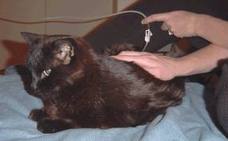
Once they are discharged, they will need regular treatments of fluid under the skin to keep them hydrated, as most cats in stage 3 cannot maintain their hydration at all. if they consistently are left to be dehydrated, their kidneys will slowly become more and more deprived of nutrition and oxygen as when they are dehydrated the blood flow through the kidneys decreases. they will then quickly progress to stage 4. The subcutaneous fluids done regularly twice a week initially and then reducing to once a week to once a fortnight in stable cases really helps to slow progression of kidney failure. These treatments can be done at home by owners or at the vets – most times the owners can drop the cat off for ten minutes to have it done and the cat will not need to stay for the day.
Stage 4: Creatinine greater than 439 umol/l. ADVANCED RENAL FAILURE
This is the end stage of chronic renal failure and requires drastic intervention. Treatment at this stage involves drips and hospitalisation, often for up to three days. Cats are also tempted to eat and tube fed if they don’t – often at this stage they tend to not eat well at all. They are put onto tablets like Benazepril that alter the blood flow through the kidneys to maximise it. Cats that improve, which not all do, are sent home but usually have to continue with fluids like saline under the skin at least twice a week to keep them hydrated until they are a lot more stable and eating on their own. Cats may be put onto appetite stimulants and drugs for nausea to get them to eat as well as oral phosphate binders if their phosphate levels are raised.
WILL MY CAT RECOVER FROM STAGE THREE OR FOUR KIDNEY FAILURE?
Not all cats get better. Whether or not they get better doesn’t always depend on their kidney values as I have seen some cats that have had high kidney enzyme values eat and improve whereas others with lower values simply do not. Owners should be aware that there is no cure and all the treatment is just there to make their pet comfortable and happy for a few months at most. Many owners feel that the amount of intervention needed at this stage negatively affects the quality of life and some do make the sad decision to put their cat to sleep. If there is cancer in the kidney or a viral disease such as FIP, then unfortunately the prognosis is poor. But each cat is different and I always advise to give them a chance on a drip to see how they respond. If the Creatinine is over 900 umol/l, unfortunately they rarely survive.
LONG TERM MONITORING OF RENAL DISEASE
Your vet will ask you to bring your cat in every 3-6 months depending on how advanced his kidney disease is. Your vet will take a blood sample and a urine sample and have a look at how your cat is doing, weigh your cat and take the blood pressure. If the kidneys had any abnormalities such as swelling or lumps on them on the previous scan, your vet will recommend a follow up scan to assess them again.
Unfortunately we cannot stop the kidneys getting old. The most we can do is give them the best chance of aging slowly by taking excess strain off of them and at the same time, make your cat feel better ad improve his quality of life.

Leave a Reply
You must be logged in to post a comment.